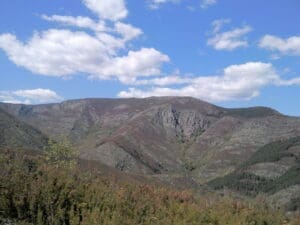The youngest of the D.O.
It is located in the south of the province, near the border with Portugal, extending through the Támega river valley.
Here, white godello and red mencía grapes are predominantly cultivated, on an area of just under 500 hectares that produces two million liters per year.
The archaeological remains found in the region, such as presses, rock-carved wine presses, and Roman-origin vessels, evidence the participation of the latter in the introduction of viticulture in Monterrei.
Since the late 9th century, vine cultivation expanded throughout the region by religious orders, as wine was used as a tribute for payment to monasteries and feudal lords.
The territory of the Monterrei Designation of Origin belongs to the Duero river basin, as the Támega river, which crosses the region from north to south, flows into it. It has a temperate Mediterranean climate with a continental tendency, influenced by the Atlantic Ocean. Its summers are hot and dry while its winters are cold. The area presents considerable thermal oscillations, up to 20º during the ripening period.
In the Monterrei region, three types of soils are present: Slate and schist, ideal during drought periods, providing aromas in red wines. Granite and Sandy: originating from the degradation of granite rocks, they have low pH, suitable for white wines. Sedimentary: complex due to the mixture of materials.
Monterrei Wine Route
Those who travel the Monterrei Wine Route will discover a different landscape, a path bathed in the colors of wine, enriched by its history, gastronomy, and above all, by the kind hospitality of its people.
The Monterrei Wine Route is located in a region with great cultural wealth, where monuments such as the Monterrei Castle, the largest acropolis in the community and where the first Galician incunabulum was printed, the pre-Romanesque church of Mixós, the church and cloister of La Merced (which houses the Mercedarian Cloister Museum, with a specific area dedicated to the D.O. Monterrei), the House of the Acevedo (which hosted a meeting between Philip the Handsome and Cardinal Cisneros), José García Barbón square (historical patron and philanthropist of the town) or the House of the Shield (dated 1737), among others, emerge.
One cannot overlook a resource strictly linked to viticulture, which is the Route of the Rock Wine Presses located in Oímbra. It is the municipality in Galicia with the most documented rock wine presses, and this route, besides discovering spectacular landscapes, allows one to learn about different models of wine presses (one of them restored, such as the Xan Preto) and the Barrocas winery-wine press.
The Monterrei Wine Route hosts a great variety of places worth visiting and remembering. Nature is spectacular, as shown by the Invernadeiro Natural Park (with Castrelo do Val municipality as its gateway), the Cidadella waterfall (Vilardevós), Pozo do Demo (Verín), the birdwatching routes along the Támega river Ecovía, the centuries-old chestnut groves in Riós, or the mineral-medicinal water springs (Cabreiroá, Sousas, Fontenova, Caldeliñas, and Fonte do Sapo), which are part of the Thermal and Water Route – European Cultural Itinerary. Not to forget, the passage through the territory of two variants of the Camino de Santiago: the southeast route of the Vía de la Plata (coming from Zamora) and the Portuguese Interior Route (from Chaves -Portugal-).
A whole natural, artistic, and cultural heritage to which the local gastronomy must be added, with products such as peppers (IXP Pemento de Oímbra), mushrooms and chestnuts (with their own celebration in Riós), cod, empanadas, kid, pork derivatives (Chorizo Festival in Ábedes -Verín-), and sweets such as bicas, bishop’s tongues, or Cigarrón cake. A cake that bears the name of the Verín Carnival figure, declared a National Tourist Interest Festival in 2009.
Everyone who visits Monterrei will feel that they are in a different land, with centuries-old paths, pilgrimage routes, popular architecture, endless mountains, wild nature, and above all, wine, good wine.

 Galicia
Galicia


 Provincia de Ourense
Provincia de Ourense 










